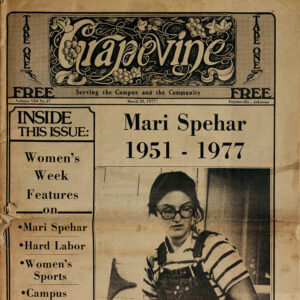calsfoundation@cals.org
Grapevine
The Grapevine, published from 1970 to 1993, was a weekly newspaper based in Fayetteville (Washington County). It began as an off-campus University of Arkansas (UA) student publication and evolved into an alternative news source for the broader northwestern Arkansas community, with a focus on Fayetteville arts and culture, student life, and progressive politics.
The paper officially began as a weekly published off campus by the Arkansas Student Free Press Association, beginning on March 18, 1970, although longtime Grapevine editor Peter Tooker suggested that it may have had its origins the previous year as an underground campus paper focused on Greek life and concerns at UA. The paper’s founder and editor in 1970 was Richard (Cid) Sutoris Jr.; while a student at UA, he’d been editor of The Traveler, the main UA paper from 1965 to 1966. For the 1970–71 school year, Sutoris named Paul Blume as the Grapevine’s editor. Blume was a junior at UA and had experience working with the UA Business College’s The Guild Ticker and the Razorback yearbook. Sutoris sold the Grapevine to Kenny Pollock, who owned it until 1974, when he was bought out by The Grapevine, Inc.
The newspaper’s first office was in a small shop on North West Ave., near the corner of West and Lafayette. It also had an early office on West Sixth St. and an early headquarters at 502 S. School St. Around 1976, its office moved to 111 W. Lafayette St. Early editors were Sutoris (1970), Blume (1970–1971), John Toney (1971–May 1972), Matt Horan (May 1972–May 1973), Joe Eblen (May 1973–June 1976), Doug Howard and Brenda Pappas (June 1976–1978), Mike Gauldin, and Peter Tooker.
The Grapevine’s inaugural issue touted the paper as an unusual, fun alternative to the dailies. Its emergence as an alternative outlet for student voices coincided with a period of increased oversight of The Traveler by the UA Board of Publications and related personnel turnover and irregular publishing schedules for The Traveler during the early 1970s. The Grapevine followed in the footsteps of other alternative UA student publications such as X-Ray (1912), The New Deal Leader (1948), the Arkansas Advocate (1965), ‘Scuse Me (1966), and the Ozark Mountain Times (1970–1972). It was also joined by contemporaries The System (1979–1980) and Darkhorse (1979–1981).
The paper’s investigative reports, particularly regarding campus issues, were occasionally picked up by more mainstream publications (though sometimes with skepticism). Newspaper staff had occasional run-ins with campus authorities, such in 1978 when a female Grapevine reporter used another reporter’s press pass to access a men’s locker room (at the time, female reporters were banned from the men’s locker rooms). The Grapevine’s press access was temporarily revoked. Often blunt in its editorials and its critiques of campus governance, the paper offered significant competition to The Traveler. By 1985, the paper claimed a circulation of 8,000, with over sixty distribution locations in the region.
The Grapevine’s writing and editorial staff included a number of people who would go on to careers in Arkansas journalism, literature, and politics. These alumni included noted children’s author Otto Salassi, who served as a sports editor and columnist; novelist Donald Harington, who authored several art reviews for the paper; Steve Anderson, an editor of the Grapevine who later became managing editor of the Washington County Observer; Richard S. Drake, who wrote the Street Jazz column for the Grapevine and later became editor of another Fayetteville alternative paper, the Ozark Gazette; and Mike Gauldin, another Grapevine editor, who later served as Governor Bill Clinton’s press secretary.
The Grapevine went up for sale in 1986 and was purchased by siblings John and Nancy Cooper Maier; Nancy served as editor and John as publisher. Under their leadership, the paper moved into new offices (in the John S. Vest House at 21 N. West Avenue) and entered a new era, becoming more involved in covering local politics and less focused on campus life.
On July 16, 1993, the newspaper’s publisher announced a yearlong sabbatical; it never returned to publication. When the editorial announcing the hiatus mentioned lack of community support, an advertisers’ boycott, and lack of cooperation from local governmental agencies as some of the contributing factors to the decision was published, its accusatory language sparked criticism in the editorial pages of the Northwest Arkansas Times. Other newspapers emerged to fill the alternative news vacuum, including Fayetteville Begin later in 1993, Ozark Gazette in 1995, and the current The Free Weekly in 1994.
For additional information:
Alison, Charles Yancey. “The Arkansas Traveler: The First Seventy-Five Years of a Student Newspaper.” MA thesis, University of Arkansas, 2004.
Drake, Richard S. Ozark Mosaic: Adventures in Arkansas Alternative Journalism, 1990–2002. New York: iUniverse, 2004.
Grapevine Newspaper Records. Special Collections. University of Arkansas Libraries, Fayetteville, Arkansas.
Robinson, Deborah. “Grapevine to Go on Year’s Leave.” Northwest Arkansas Times, July 21, 1993, pp. A1, A10.
———. “Tooker Remembers the Grape’s Beginnings.” Northwest Arkansas Times, August 17, 1993, pp. A1, A7.
Katrina Windon
University of Arkansas, Fayetteville
 Divergent Prosperity and the Arc of Reform, 1968–2022
Divergent Prosperity and the Arc of Reform, 1968–2022 Mass Media
Mass Media Grapevine
Grapevine 




Comments
No comments on this entry yet.